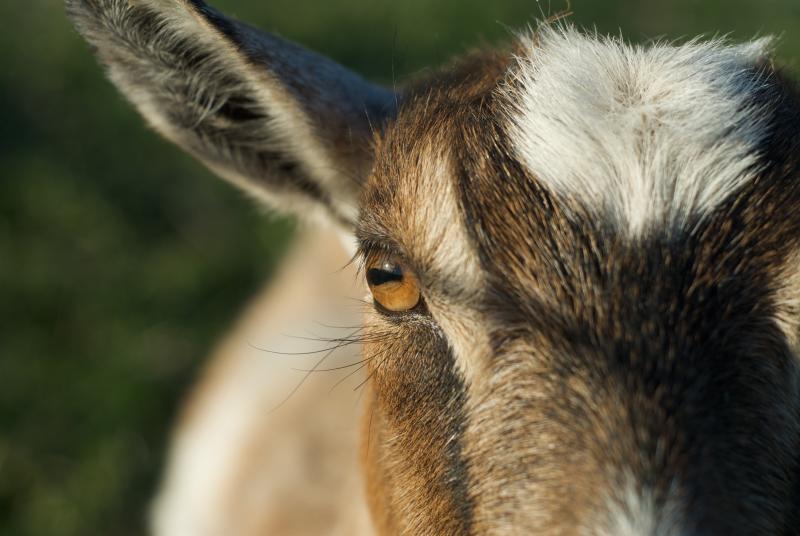Through the Eyes of Prey: How Goats and Sheep Evolved Rectangular Pupils for Survival
Out on the rugged rangelands, a herd of vigilant goats monitors the scrubby hills for any lurking threats. Suddenly, a mountain lion explodes from cover. But using their unique rectangular pupils, the goats detected the hunter before its lethal rush. Now the herd scrambles away using vision uniquely adapted to escape predators and navigate rocky slopes at speed.
This scene illustrates why evolutionary pressures gifted goats, sheep and other prey with weirdly rectangular eyes. By enhancing field of view and terrain clarity, horizontally-elongated pupils provide herbivores with advantages that determined survival for eons.
The Advantages of Rectangular Vision
Unlike circular human pupils, goats, sheep and other ungulates share vertically narrow, horizontally wide rectangular pupils. Research shows horizontal slits significantly broaden visual perspective compared to other pupil forms.
This panoramic configuration allows animals to scan surroundings for predators without needing to pivot heads. Goats gain almost 300-degree peripheral vision from their sideways-stretched pupils. Likewise, sheep eyes can even tilt within their sockets to further expand vista.
The resulting viewpoint eclipses most mammals’ visual limitations. Goats and sheep essentially sport built-in widescreen TVs showcasing everything from their left, front and right peripheries simultaneously without turning heads. This lets them continually monitor the horizons and surrounding landscape as they graze vulnerable with heads lowered, maximizing safety.
Sharpening Slopes and Predator Detection
Beyond boosting environmental awareness, rectangular pupils also sharpen visual clarity and depth especially in forward directions. This helps fleeing sheep and goats rapidly navigate uneven terrain and react to sudden threats.
Horizontal pupils thus enhance both motion detection in the periphery plus terrain and obstacle resolution in central vision – perfect adaptations for escaping predators. As highly vulnerable prey, goats and sheep use rectangular pupils as evolutionary aids to better see sneaky predators and outrun them once detected.
These unique eyes also optimize lighting conditions for crepuscular species active around dawn and dusk. In dim conditions, sheep and goats’ pupils widened horizontally collect more light to optimize whatever illumination exists. Meanwhile narrow vertical spacing blocks distracting sky glow at sunrise and sunset.
All together, horizontally-oriented pupils serve great purposes for vulnerable grazing species. They expand awareness, sharpen priority visual cues, and take advantage of ambient lighting to best navigate rugged habitat.

Rectangular Eyes Beyond Goats and Sheep
Interestingly, goats and sheep aren’t alone in adapting rectangular pupils. Other hoofed animals like deer, antelope and horses also evolved horizontally-aligned eyes to enhance field of vision and terrain visibility. Even some snakes feature vertically-narrow rectangular pupils.
The common denominator seems to be species requiring expanded perspective to watch for predators combined with frontal visual resolution to flee safely. This generally holds true whether the prey animal is a small duiker antelope on the African savanna or an enormous Clydesdale horse pulling wagons in Scotland.
In most cases, only plant-eating prey species benefit from the trade-offs of horizontal pupils. Bold predators like lions rely more on precise depth perception than panoramic breadth to target prey. So cats instead wield vertical slits, while other ambush specialists even shrink pupils into pinpricks hardly letting any light escape.
Each pupil design suits ecological strategy, hammered home through aeons of natural selection. Prey manifold survival by expanded eyesight, whereas hunters refine vision for acute targeting. Eyes wonderfully customize through evolution to fill environmental niches across habitats and lifestyles.
The Strangeness of Sideways Sight
Goats and sheep hardly seem unusual roaming bucolic meadows worldwide. But peek into their funky sideways-stretched eyes and weirdness multiplies. What must landscapes appear as through such freakishly rectangular windows?
Probably first comes corrected distortion, so nearby foliage aren’t oddly skinny or stretched. Natural selection likely long compensated optics for accurate depth and distance gauging through sideways pupils.
Still, peripheral vision spanning three football fields probably imparts uniquely immersive sensations. With boosted light sensitivity across widened retinas during crepuscular phases, vision surely takes on painterly dimensionality. Entire rangeland vistas beam sharper focus directly forward for precision traversal while peripheries monitor with telescopic scale.
Would acrophobia emerge from ledges seeming to yawn vastly wider through squat rectangular portholes? Do charging companions look laughably widescreen playing across the eyes’ cinematic horizons? We can only speculate how goats and sheep perceive existence through their graphs-come-alive pupillary rectangles. It must paint life through their own visual geometry we can scarcely envision.
But what does remain certain is this: those alien-looking rectangular eyes serve critical, lifesaving purposes. They expand awareness to avoid ambush, sharpen terrain details imperative during sprints, and modulate light for crepuscular navigation. Through profound evolutionary enhancements encoded in eye anatomy, goats and sheep reveal how function spawns form. Vision and vitality entwine by necessity across life’s unfolding.
So next time you encounter a placid rectangular-eyed ewe munching grass, consider that her very gaze signifies epic adaptation. Behind that sideways stare unfolds living history chronicling 60 million years of evolutionary refinements elegantly distilled into a elongated iris. Hardly the stuff of textbooks or labs, her visual legacy still roams untamed pastures worldwide thanks to such sublime optical engineering honed exquisitely through the ages.



